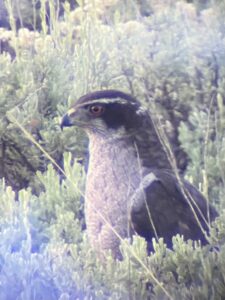BY HARRY WEEKES

Human minds are built on a simple fact—in the great trophic pyramid, we are prey. This means that we spent our early days (as a species) doing a whole lot of looking around. And not the casual, side-to-side, measured patient looking around of things like tigers and bears, but rather the twitchy, nervous, back-and-forth looking around of things like mice. Do you ever wonder why you are so good at picking out a snake in the grass, or zeroing in on a wasp that hovers nearby, or snapping into convulsions at the faintest feeling of an insect crawling on your neck? It’s called stayin’ alive, baby.
Watch anyone’s eyes and you will notice they are constantly scanning the world. Sure, we are looking for snacks and loved ones, but we are also looking for that telltale something indicating things are amiss—the bent piece of grass, the shadow at the base of the bushes, or that slightly different smell in the air.
History is hard to shake. Since we have moved, mostly, into a more predatory role, this constantly alert brain can be put to more casual pursuits, like, “Hmmm, there was something about that grouse that didn’t totally make sense.”
And so it was, in the late-afternoon light, that a grouse skimmed across the sage and made its normal, inelegant landing in the brush. Penelope said, “Is that a grouse?” I said “Yes,” but with an inkling of uncertainty that had me up and heading for my binoculars.
Everything seemed pretty grouse-y: heavy bird, dark feathers, sagebrush. Then, in finding the bird in my binoculars, two things were immediate—a red eye and a hooked beak. These features were decidedly non-grouse-y. Sitting a hundred yards away was a northern goshawk; only the second one I have ever seen, and the first I had seen near my house.
Over the next three nights, he or she returned to perch, momentarily, on a sagebrush, before jumping to the ground and running, very Velociraptor-esque, across the ground. By the third night, I was casually saying, “The goshawk’s back,” having easily encoded it into my mind.
This ‘it’ was the specific bird and also, more generally, what birders call the GISS—the general impression of shape and size. This is the algorithm for trying to figure out what you are looking at. Was it the size of a robin or a chicken? Did it undulate like a woodpecker or fly straight like a crow? Were its wings long and narrow or short and stubby? Now, my general impression of a big bird swooping in across the sage in the evening includes a goshawk.
Our brains were forged over millennia as we tried to do two things—reproduce, and stay alive until we reproduced. The ones that made it, well, were the ones that made it—the ones that did not meet some untimely demise.
This iterative process has given us the remarkable ability to pick up seemingly imperceptible changes in our environment. In this case, to catch a fleeting glance of an assumed bird and reveal it as something altogether different and unusual.
I then got to sit back with my brain and enjoy this predator as it stalked through sage, no doubt looking for prey, taking even the slightest break from looking for it, continuing the ongoing dance, this time in the underbrush of Indian Creek.
Harry Weekes is the founder and head of school at The Sage School in Hailey. This is his 50th year in the Wood River Valley, where he lives with Hilary and one of their three baby adults—Simon. The other members of the flock, Georgia and Penelope, are currently fledging at Davidson College in North Carolina and Middlebury College in Vermont.


